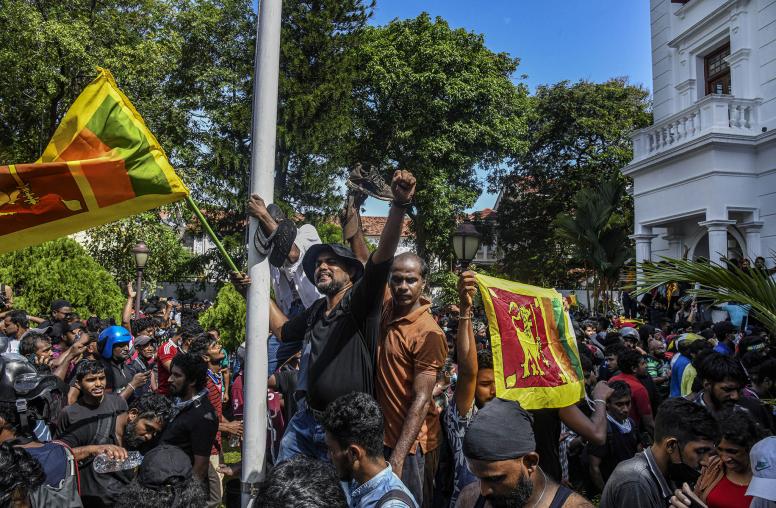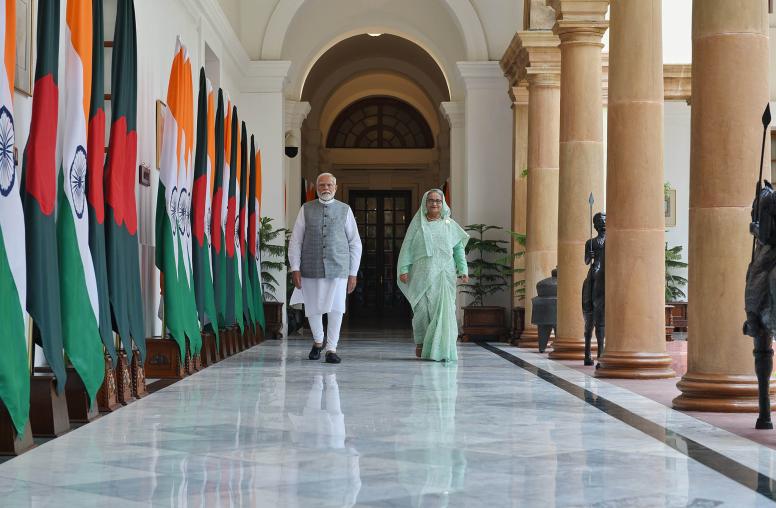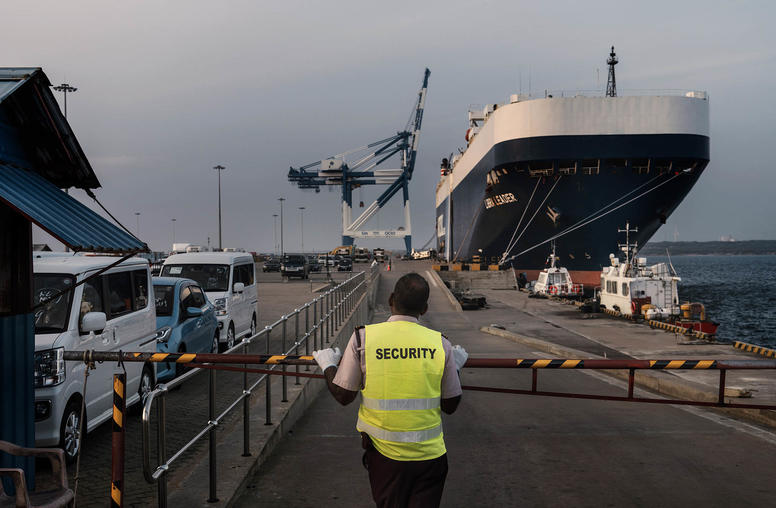A Year After Mass Protests, Sri Lanka’s Governance Crisis Continues
The country’s economy appears to be making a slow and steady recovery, but its governance challenges must be addressed to sustain the momentum.
One year after the Sri Lanka’s massive unrest, known as the Aragalaya protests, the country is still dealing with the aftermath of its most devastating economic crisis since independence, a government without popular support and intensifying geopolitical competition in its neighborhood. The protests, spurred by the economic crisis, led to mass resignations across the government with former President Gotabaya Rajapaksa fleeing the country in July 2022. In the year since, the country has secured an IMF agreement, and its economy has ambled toward a slow path of recovery. However, there have still been concerns on the human rights front as the current government of Ranil Wickremesinghe has clamped down on further protests and continually postponed elections.

Ambika Satkunanathan, the former commissioner of Sri Lanka’s Human Rights Commission, Verité Research Executive Director Nishan de Mel and USIP’s Nilanthi Samaranayake examine the ways Sri Lanka’s domestic politics, economics and foreign relations have evolved one year after the country-wide protests.
One year after the Aragalaya and the removal of President Rajapaksa, what is the state of politics in Sri Lanka?
Satkunanathan: The government of Wickremesinghe, who was elected president by the Sri Lanka Podujana Peramuna (SLPP) — the party of the once politically dominant Rajapaksa family — is engaged in sustained efforts to enact repressive laws that stifle dissent and curtail the freedoms of media and civil society. Since parliamentary elections have not been held in the aftermath of the political crisis the current government is the same as the one headed by Gotabaya — the only difference is that Wickremesinghe is the president. Although the conditions of the IMF bailout package have pushed the government to propose some reforms, such as a new anti-corruption law, the lack of political will makes it unlikely that these initiatives will precipitate change in government behavior. Particularly since those in Parliament are the very same people who were part of the Gotabaya Rajapaksa regime and responsible for the multi-dimensional crisis with which Sri Lanka is still grappling. These parliamentarians have been reportedly demanding ministerial portfolios from Wickremesinghe to continue their support to him, thereby demonstrating the ongoing corrupt political culture and lack of accountability.
The military continues to acquire land in the north and east to expand military camps. Security agencies and the military have continued their surveillance, intimidation and harassment of civil society organizations, the media, families of the disappeared, former combatants and Tamil political and civic activity in conflict-affected areas. The draconian Prevention of Terrorism Act, which does not adhere to international human rights standards and the implementation of which has resulted in human rights violations, is still on the statute books. As part of the Sinhalization of the north and east, which has rapidly escalated, Hindu temples are being destroyed and in their place Buddhist temples being built.
There has also been no progress in holding perpetrators of human rights violations related to the war accountable. Nor has there been any attempt to provide a political solution to the ethnic conflict or undertake substantive constitutional reform. Instead, to avoid being subject to the scrutiny of the U.N. Human Rights Council, the government is proposing the establishment of the National Unity and Reconciliation Commission, its version of the truth-seeking mechanism, while hundreds of recommendations of similar previous commissions remain unimplemented.
Were the protests successful in achieving the constitutional and political changes demanded? Has there been any impact on reconciliation or minority rights?
Satkunanathan: The 2022 protests did ignite increased public discourse on issues of public interest and demands for accountability, at least on certain issues, such as how public funds are spent and corruption. Yet, the decades-long rights struggle of communities — such as the Tamils, which have challenged the state and particularly the Rajapaksas — was largely absent in the narrative and the consciousness of the protesters.
Increased political awareness among the southern public has the potential to be the beginning of the acknowledgment of historical discrimination and repression, which should ideally result in the south heeding and addressing calls for truth, justice and equal citizenship. Such realization can lead to a pluralistic and diverse Sri Lanka where one would not have to divest one’s ethnic or religious identity to be Sri Lankan.
Hence, legal reforms alone will not change the way Sri Lanka’s institutions and politicians behave and perform. To ensure that the momentum generated in 2022 for accountability from elected representatives evolves into sustained challenges to entrenched systems of discrimination and corruption, the root causes of Sri Lanka’s crises and the multiple elephants in the room must be addressed.
A year ago, Sri Lanka defaulted on its international debt after facing unprecedented inflation and a balance of payments crisis. After default and securing a new IMF program, what is the current state of the Sri Lankan economy? How has Sri Lanka dealt with its domestic and international debt burden?
De Mel: Sri Lanka is coming out of a very rough period. By all quantifiable measures, it is the worst economic crisis Sri Lanka has faced since gaining independence in 1948. In 2022, with its GDP contracting by 7.8%, Sri Lanka was one of the worst performing economies in the world. Annual inflation was around 60%, and the currency depreciated by over 80%. These quantifiable measures of pain were exacerbated by severe shortages and uncertainty in accessing fuel, gas and medicines. Daily power cuts became normalized.
Much of this was avoidable. Sri Lankan decision makers waited much too long to suspend international debt repayments. They paid international creditors until foreign reserves were virtually down to zero and further payments could not be made. These decisions heaped untold misery on people’s lives and imploded the economy. Sri Lanka’s economic crisis arose not simply from economic factors, but mainly from an ongoing crisis of governance.
In September 2022, Sri Lanka reached a staff-level agreement with the IMF for an Extended Fund Facility Program. Two hundred days later, in March 2023, it secured a board-level agreement as well. Alongside that, the currency appreciated by about 15% and the government approval rating, which was as low as 10% in February, doubled to 21% in June. Price increases have been contained in 2023. The annualized inflation in the first half of 2023 was below 5%, exceeding the expectations set out by the IMF. Market interest rates, which had edged above 30%, have now come below 20%. Sri Lanka has got past the zenith of its crisis and is looking forward to a slow and steady recovery.
Domestic debt restructuring (DDR) was announced at the end of June, ahead of restructuring external debt. It had an unexpected twist. The DDR has focused the cuts exclusively on the retirement savings of private sector workers. Analytically, it remains unclear whether the overall measures announced for debt restructuring can pave a sustainable path beyond 2032, which is the planning horizon of the IMF program.
Meanwhile, the lack of analysis to support economic policies, inequitable distribution of the burden of DDR and unabated corruption, all point to a crisis of governance. This is impacting the IMF program as well. Most of the program commitments that are still overdue are those related to governance. By all indications, rent-seeking vested interests still have huge sway over government decision-making. (Sri Lanka’s progress on the IMF program can be followed on Verité Research's IMF Tracker.)
Looking forward, whether the present recovery can gain momentum and be sustainable will depend on two factors: One, how deeply Sri Lanka is able to restructure its external debt; and two, how much it can reform its broken system of governance.
In what ways has Sri Lanka’s relationships with regional powers India and China changed since the height of the economic crisis?
Samaranayake: Sri Lanka’s relationship with New Delhi has grown considerably stronger along economic and diplomatic lines, while their already close defense ties are largely unchanged. By contrast, China’s response has been highly disappointing to Sri Lanka, which continues to wait on Beijing’s full cooperation in debt restructuring.
India’s economic support to Sri Lanka predates the 2022 crisis. In 2020, New Delhi agreed to a $400 million currency swap under the South Asian Association for Regional Cooperation (SAARC) framework. For more than a year, India was reportedly silent on whether it would approve Sri Lanka’s requests for an additional $1.1 billion currency swap and a moratorium on bilateral debt. Since early 2022, however, India’s support for Sri Lanka has been unprecedented. New Delhi perhaps realized the trendline of the impacts to the south was increasingly linked to its own economic and security interests and the credibility of its "neighborhood first” diplomacy.
The nature of support has been mostly lines of credit, currency swaps and deferred repayments. In January 2022, India provided another currency swap of $400 million under the SAARC framework. It also deferred settlement of $2 billion in Sri Lanka’s Asian Clearing Union trade credits, which are mostly for imports from India. In February 2022, it offered a line of credit worth $500 million for importing fuel from India, and the following month it provided a credit facility of $1 billion to buy food and medicine from India and further aid worth roughly $72 million. No less significantly, in January 2023, New Delhi provided the first assurances to the International Monetary Fund to enable the latter’s $2.9 billion package. Recently, India extended its $1 billion credit line for another year and appears likely to offer Sri Lanka a 12-year term to repay its debts. Later this month, President Wickremesinghe will make his first visit to India since entering office.
Beyond economic and diplomatic ties, India continues to be Sri Lanka’s primary defense partner. In the past year, the Sri Lanka Air Force has received a Dornier maritime surveillance aircraft from India, while the two countries held their annual defense dialogue in February and the Sri Lanka-India naval exercise, SLINEX, in April.
In contrast, China has been mostly uncooperative despite being Sri Lanka’s largest bilateral lender. Earlier, it had offered a currency swap worth $1.5 billion that was subsequently criticized because Sri Lanka could not benefit from its stringent terms. It also offered another $500 million loan with interest in 2021. Most importantly, China’s reluctance to actively participate in the debt-restructuring process with other lenders has cemented deeply held concerns about its transactional approach to Sri Lanka and other growing economies. Earlier this year, China finally agreed to a moratorium on debt servicing to Sri Lanka for only two years. But questions remain about whether Beijing will deliver on its assurances about debt restructuring.
Nevertheless, Sri Lankan officials representing their smaller state cannot afford to criticize China. Instead, officials emphasize their hope that Beijing will cooperate on the debt crisis and in other areas of the relationship. Wickremesinghe is expected to visit China in October to seek foreign direct investment in several projects, including for a potential $4 billion oil refinery in Hambantota.



